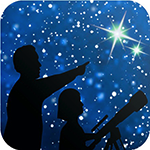Have you ever wondered how many stars you can see at night? From a perfect dark sky location, free from any light pollution, a person with excellent vision may observe a few thousand stars in the sky at one time! Sadly, most people don’t enjoy pristine dark skies – and knowing your sky’s brightness will help you navigate the night sky.
Category Archives: NASA Space Place
Visitors to Both Jupiter and Saturn
Have you observed Jupiter and Saturn moving closer to each other over the past few months? On December 21, the two worlds will be at their closest, around 1/5 of a full Moon apart! While the two gas giants may appear close, in reality they are hundreds of millions of miles apart. Despite this vast distance, a select few missions have visited both worlds by using a gravity assist from giant Jupiter to slingshot them towards Saturn, saving time and fuel.
Observe the Skies Near Mars
October is a banner month for Mars observers! October 6 marks the day Mars and Earth are at closest approach, a once-every-26-months event. A week later, on October 13, Mars is at opposition and up all night. Mars is very bright this month, and astronomers are eager to image and directly observe details on its disc; however, don’t forget to look at the space around the planet, too! By doing so, you can observe the remarkable retrograde motion of Mars and find a few nearby objects that you may otherwise overlook.
Summer Triangle Corner: Altair
Altair is the final stop on our trip around the Summer Triangle! The last star in the asterism to rise for Northern Hemisphere observers before summer begins, brilliant Altair is high overhead at sunset at the end of the season in September. Altair might be the most unusual of the three stars of the Triangle, due to its great speed: this star spins so rapidly that it appears “squished.”
Summer Triangle Corner: Deneb
The Summer Triangle is high in the sky after sunset this month for observers in the Northern Hemisphere, its component stars seemingly brighter than before, as they have risen out of the thick, murky air low on the horizon and into the crisper skies overhead. Deneb, while still bright when lower in the sky, now positively sparkles overhead as night begins. What makes Deneb special, in addition to being one of the three points of the Summer Triangle? Its brilliance has stirred the imaginations of people for thousands of years!
Mars’s Latest Visitor: NASA’s Perseverance Rover
NASA’s latest Mars rover, Perseverance, is launching later this month! This amazing robot explorer will scout the surface of Mars for possible signs of ancient life and collect soil samples for return to Earth by future missions. It will even carry the first off-planet helicopter: Integrity. Not coincidentally, Perseverance will be on its way to the red planet just as Mars dramatically increases in brightness and visibility to eager stargazers as our planets race towards their closest approach in October of this year.
Summer Triangle Corner: Vega
David Prosper and Vivian White
NASA JPL
If you live in the Northern Hemisphere and look up during June evenings, you’ll see the brilliant star Vega shining overhead. Did you know that Vega is one of the most studied stars in our skies? As one of the brightest summer stars, Vega has fascinated astronomers for thousands of years.
Become a Citizen Scientist with NASA
Ever want to mix in some science with your stargazing, but not sure where to start? NASA hosts a galaxy of citizen science programs that you can join! You’ll find programs perfect for dedicated astronomers and novices alike, from reporting aurora, creating amazing images from real NASA data, searching for asteroids, and scouring data from NASA missions from the comfort of your home. If you can’t get to your favorite stargazing spot, then NASA’s suite of citizen science programs may be just the thing for you.
Hubble at 30: Three Decades of Cosmic Discovery
The Hubble Space Telescope celebrates its 30th birthday in orbit around Earth this month! It’s hard to believe how much this telescope has changed the face of astronomy in just three decades. It had a rough start — an 8-foot mirror just slightly out of focus in the most famous case of spherical aberration of all time. But subsequent repairs and upgrades by space shuttle astronauts made Hubble a symbol of the ingenuity of human spaceflight and one of the most important scientific instruments ever created. Beginning as a twinkle in the eye of the late Nancy Grace Roman, the Hubble Space Telescope’s work over the past thirty years changed the way we view the universe, and more is yet to come!
Dim Delights in Cancer
Cancer the Crab is a dim constellation, yet it contains one of the most beautiful and easy-to-spot star clusters in our sky: the Beehive Cluster. Cancer also possesses one of the most studied exoplanets: the superhot super-Earth, 55 Cancri e.
